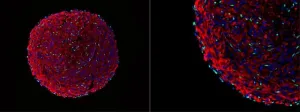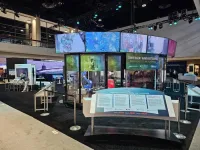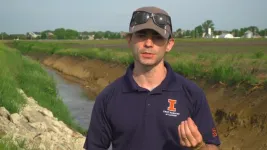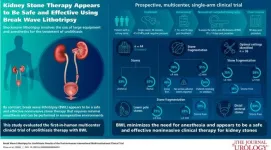(Press-News.org) Avian influenza A(H5N1) virus, which spread to cattle and infected 14 people this year, was detected using virome sequencing in the wastewater of 10 Texas cities by researchers at UTHealth Houston and Baylor College of Medicine. The virome is the collection of viruses in a sample, in this case a wastewater sample.
The information was published in the New England Journal of Medicine.
Until March 2024, H5N1 had not been detected in 1,337 wastewater samples analyzed by the team. But from March 4 to July 15 (the end of data collection for this article), H5N1 was detected in 10 of 10 cities, 22 of 23 sites, and 100 of 399 samples. However, the abundance of H5N1 in wastewater samples collected over time did not correlate with influenza-related hospitalizations over the same time period, so the risk to the public was extremely low.
UTHealth Houston and Baylor established the wastewater testing program as part of the Texas Epidemic Public Health Institute (TEPHI).
The sequencing protocol used by the team can detect genetic changes that might indicate an adaptation of the virus to mammals, perhaps even humans. Lack of clinical burden in humans and genomic information suggested that the source of the virus load found in wastewater during that time span came from animal origins. But continued surveillance is critical for monitoring any evolutionary adaptations that would indicate the potential for it to jump to humans, the researchers concluded.
Lead authors of the journal letter were Michael J. Tisza, PhD, assistant professor of molecular virology and microbiology at Baylor; Blake Hanson, PhD, assistant professor in the Center for Infectious Diseases at UTHealth Houston School of Public Health; Eric Boerwinkle, PhD, director of TEPHI and the dean, Kozmetsky Family Chair in Human Genetics, and M. David Low Chair in Public Health of the School of Public Health; and Anthony W. Maresso, PhD, the Joseph L. Melnick Chair of Virology at Baylor. Boerwinkle and Hanson are also members of The University of Texas MD Anderson Cancer Center UTHealth Houston Graduate School of Biomedical Sciences.
The team detects viruses in wastewater by using a viral probe capture set targeting thousands of viral species or variants. Since May 2022, TEPHI has detected more than 400 human and animal viruses, several of which (SARS-CoV-2, influenza, and mpox) have correlated to clinical case data in the population.
Letter co-authors from UTHealth Houston included Kristina Mena, PhD, the Jane Dale Owen Chair in Environmental Health Protection; Anna Gitter, PhD; Fuqing Wu, PhD; Janelle Rios, MPH, PhD; and Jennifer Deegan, MPAff. From Baylor College of Medicine: Justin Clark, PhD; Li Wang, MD, PhD; Katelyn Payne, BS, Matthew Ross, PhD; Sara Javornik Cregeen, PhD; Juwan Cormier, PhD; Vasanthi Avadhanula, PhD; Austen Terwilliger, PhD; Pedro Piedra, MD; Joseph Petrosino, PhD. John Balliew, with the El Paso Water Utility, was also a co-author.
END
Avian flu found in wastewater of 10 Texas cities through virome sequencing by researchers at UTHealth Houston and Baylor College of Medicine
Results published in New England Journal of Medicine
2024-09-11
ELSE PRESS RELEASES FROM THIS DATE:
Culturing muscle cells
2024-09-11
Harvard stem cell biologists have pioneered a groundbreaking 3D organoid culture method for generating large numbers of adult skeletal muscle satellite cells, also known as muscle stem cells, in vitro.
The ability to efficiently make functional muscle stem cells in this way is expected to accelerate understanding of and treatments for disorders of skeletal muscle, including those that are neuromuscular in origin. The new technique, detailed in Nature Biotechnology, also provides a powerful tool for studying muscle biology.
"People will be able to do all these engraftment and regeneration experiments because suddenly, you have millions of cells,” said co-author and Harvard research ...
ORNL debuts convergent manufacturing platform at IMTS 2024
2024-09-11
A new convergent manufacturing platform, developed in only five months at the Department of Energy’s Oak Ridge National Laboratory, is debuting at the International Manufacturing Technology Show, or IMTS, in Chicago, Sept. 9–12, 2024.
The technology, called Future Foundries, opens the door for hundreds of thousands of small- and medium-sized companies to join the convergent manufacturing revolution, according to ORNL researchers. It is a cutting-edge platform that integrates multiple advanced manufacturing systems into a single, agile platform.
“The democratization ...
New insights could help prevent psychosis relapses in youth and young adults
2024-09-11
New findings from McGill University researchers could help clinicians understand the course of delusions in youth and young adults that signal the need for a timely intervention to prevent a full relapse of psychosis.
Delusions — strong beliefs that don't align with commonly accepted reality— are a defining symptom of psychosis but are not sufficiently understood.
For the first time, researchers studied whether delusion themes, such as paranoia or grandiosity, stay the same or shift between psychotic episodes in youth and young adults undergoing early intervention treatment.
The importance of timely ...
Biogeochemistry scientists from around the world, led by the ASC's Margenot, publish position paper on tackling “hidden” phosphorus
2024-09-11
As the world tries to mitigate agriculture’s effect on the environment, much of the story can be found in the soils, which stores and cycles nutrient elements of carbon, nitrogen, and phosphorus. Biogeochemistssuch as Andrew Margenot, Associate Director of the Agroecosystem Sustainability Center, are set to find answers, but for Margenot and other biogeochemistry experts who specialize in studying phosphorus cycling, the challenge is first being able to accurately measure where phosphorus has accumulated in the <100 years since humans began to increase ...
New, rare type of small cell lung cancer identified by MSK research team
2024-09-11
A team of doctors and researchers at Memorial Sloan Kettering Cancer Center (MSK) have identified a new, rare type of small cell lung cancer that primarily affects younger people who have never smoked.
Their findings, which include a detailed analysis of the clinical and genetic features of the disease, also highlight vulnerabilities that could help doctors make better treatment decisions for people diagnosed with it.
“It’s not every day you identify a new subtype of cancer,” says Natasha Rekhtman, MD, PhD, an MSK pathologist specializing in lung cancer and the first author of a paper published August 26 in Cancer Discovery presenting ...
Light pollution a new Alzheimer’s risk factor
2024-09-11
Outdoor light at night could be a significant risk factor in Alzheimer’s disease, according to new research from Rush.
While light pollution is associated with increased risk of some disorders and diseases, this is the first time it had been associated with Alzheimer’s disease.
The study was conducted at Rush University System for Health and published in Frontiers in Neuroscience.
“Our research shows that there is an association in the U.S. between Alzheimer’s disease prevalence and exposure to light at night, particularly in those under the age of 65,” said lead investigator, Robin Voigt-Zuwala, PhD, an associate professor at Rush. “Nightly ...
Clovis people used Great Lakes camp annually 13,000 years ago
2024-09-11
Graphics // Photos
The earliest humans to settle the Great Lakes region likely returned to a campsite in southwest Michigan for several years in a row, according to a University of Michigan study.
Until recently, there was no evidence that people from the Clovis period had settled the Great Lakes region. Clovis people appeared in North America about 13,000 years ago, during the geologic epoch called the Pleistocene. During the Pleistocene, sheets of glaciers covered much of the world, including Michigan, making the land inhospitable for human settlers. But a 2021 U-M study confirmed that Clovis people built ...
Can having a stroke change your sleep?
2024-09-11
EMBARGOED FOR RELEASE UNTIL 4 P.M. ET, WEDNESDAY, SEPTEMBER 11, 2024
MINNEAPOLIS – People who have had a stroke may be more likely to sleep too much or too little compared to those without prior stroke, according to a study published in the September 11, 2024, online issue of Neurology®, the medical journal of the American Academy of Neurology. The study does not prove that stroke causes abnormal sleep; it only shows an association.
“Sleeping the right amount is considered essential for ideal brain and heart health,” said study author Sara Hassani, ...
Microscale robot folds into 3D shapes and crawls
2024-09-11
ITHACA, N.Y. – Cornell University researchers have created microscale robots less than 1 millimeter in size that are printed as a 2D hexagonal “metasheet” but, with a jolt of electricity, morph into preprogrammed 3D shapes and crawl.
The robot’s versatility is due to a novel design based on kirigami, a cousin of origami, in which slices in the material enable it to fold, expand and locomote.
The team’s paper, “Electronically Configurable Microscopic Metasheet Robots,” published Sept. 11 in Nature Materials. The paper’s co-lead authors are postdoctoral ...
New noninvasive technique provides effective treatment for urinary stones
2024-09-11
September 11, 2024 — A noninvasive ultrasound technology called Break Wave™ lithotripsy (BWL) offers a safe and effective new option for treatment of urinary stones, reports a clinical trial in the October issue of The Journal of Urology®, an Official Journal of the American Urological Association (AUA). The journal is published in the Lippincott portfolio by Wolters Kluwer.
"In this initial experience, BWL provided a high treatment success rate, using a portable technology that can be used in a range of settings, without the need for anesthesia" comments lead ...
LAST 30 PRESS RELEASES:
What determines the fate of a T cell?
Candida auris: genetic process revealed which could be treatment target for deadly fungal disease
Groundbreaking discovery turns household plastic recycling into anti-cancer medication
Blocking a key inflammatory pathway improves liver structure and vascular function in cirrhosis, study finds
Continuous spread: Raccoon roundworm detected in nine European countries
HKUST Engineering researchers developed a novel photodetector to enhance the performance of on-chip light monitoring
Strategic river sensors could have forewarned of Texas Camp flood disaster
Drone sampling of whale breath reveals first evidence of potentially deadly virus in Arctic
Roman soldiers defending Hadrian’s Wall infected by parasites, study finds
Pinochet’s prisoners were tormented with music but still found solace in it, a new book reveals
Fertility remains high in rural Tanzania despite access to family planning
AI-assisted device can improve autism care access
Kinetic careers
Uncovering how parasitic plants avoid attacking themselves to improve crop resistance
Nanoparticle vaccine strategy could protect against Ebola and other deadly filoviruses
Study finds brain care score can predict risk of stroke across racial groups
Key lung immune cells can intensify allergic reactions
Do hormones explain why women experience more gut pain?
New materials conduct ions in solids as easily as in liquids
Breakthrough of the Year: Renewable energy begins to eclipse fossil fuel-based sources
LLM use is reshaping scientific enterprise by increasing output, reducing quality and more
Introducing LightGen, a chip for ultra-fast, ultra-efficient generative AI
Astronomers see fireworks from violent collisions around nearby star
ACC/AHA issue new guideline on managing congenital heart disease in adults
Cosmic crash caught on camera
Is talented youth nurtured the wrong way? New study shows: top performers develop differently than assumed
Ants: An untapped resource in the development of antibiotics?
Archaeologists use AI to create prehistoric video game
Mitochondria migrate toward the cell membrane in response to high glucose levels
Tiny viral switch offers hope against drug-resistant bacteria
[Press-News.org] Avian flu found in wastewater of 10 Texas cities through virome sequencing by researchers at UTHealth Houston and Baylor College of MedicineResults published in New England Journal of Medicine





